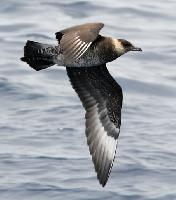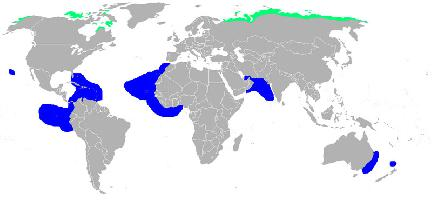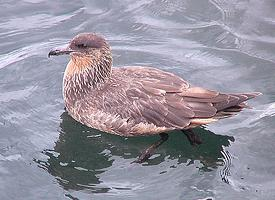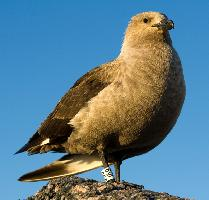
Description de l'animal
The Pomarine Jaeger (Stercorarius pomarinus) is a captivating and powerful bird of prey, belonging to the family Stercorariidae. It is renowned for its remarkable agility in flight, its striking plumage, and its intriguing behaviors, particularly during its breeding and feeding activities. This species is one of the larger jaegers, with a robust build that is perfectly adapted for a life spent predominantly over open ocean waters and, during breeding seasons, in the Arctic tundra.Physical Description:
The Pomarine Jaeger exhibits a significant degree of variation in its plumage, which can range from dark morphs to light morphs. Adult birds typically have a length of about 45-60 cm (17.7-23.6 inches) and a wingspan that stretches approximately 110-135 cm (43-53 inches). One of the most distinctive features of this species is the presence of twisted central tail feathers, which are especially pronounced in adults and can be used to distinguish it from other jaeger species. The bird's plumage is primarily brown or dark gray, with lighter shades on the underparts. During the breeding season, adults display a striking white collar around the neck and a more pronounced, pointed tail.
Habitat and Distribution:
The Pomarine Jaeger is a pelagic species, meaning it spends most of its life over the open sea, far from coastal lands, except during the breeding season. It breeds in the Arctic tundra, choosing wide, open landscapes near coastal areas for nesting. After the breeding season, it migrates southwards to spend the winter months in warmer climates, often reaching as far south as the Southern Ocean. This extensive migratory pattern allows it to inhabit a wide range of oceanic environments across the globe.
Behavior and Diet:
The Pomarine Jaeger is known for its aggressive hunting style. It often chases other seabirds such as gulls, terns, and even larger species, forcing them to regurgitate their recent catch, which the jaeger then swiftly captures. This kleptoparasitic behavior is a hallmark of the species, showcasing its mastery of aerial maneuvers and endurance. Besides stealing from other birds, it also hunts for fish and small mammals, and scavenges for food on the water's surface.
Breeding:
Breeding takes place in the Arctic tundra, where Pomarine Jaegers return each year to mate and raise their young. They are ground-nesters, laying up to two eggs in a shallow scrape on the ground, often concealed by vegetation. Both parents share in the incubation duties and are fiercely protective of their nest site, aggressively defending against any potential predators.
Conservation Status:
Currently, the Pomarine Jaeger is classified as Least Concern by the International Union for Conservation of Nature (IUCN), indicating that, at present, there are no immediate threats to its global population. However, like many seabird species, it could face future threats from climate change, pollution, and changes in the abundance of the fish stocks it preys upon.
In conclusion, the Pomarine Jaeger is a remarkable avian predator, exhibiting fascinating behaviors and adaptations that allow it to thrive in some of the world's most challenging environments. Its presence across the oceans makes it an important species for understanding the health of marine ecosystems and the impacts of global environmental changes on migratory bird species.
Carte de répartition

Animaux similaires
Nouvelles photos d'animaux
Top 10 des animaux
- Dolphin gull (Leucophaeus scoresbii)
- Japanese macaque (Macaca fuscata)
- Stone loach (Barbatula barbatula)
- Greek tortoise (Testudo graeca)
- Russian tortoise (Testudo horsfieldii)
- Galápagos tortoise (Geochelone nigra complex)
- Diana monkey (Cercopithecus diana)
- Moustached guenon (Cercopithecus cephus)
- Common flying dragon (Draco volans)
- Galápagos penguin (Spheniscus mendiculus)


